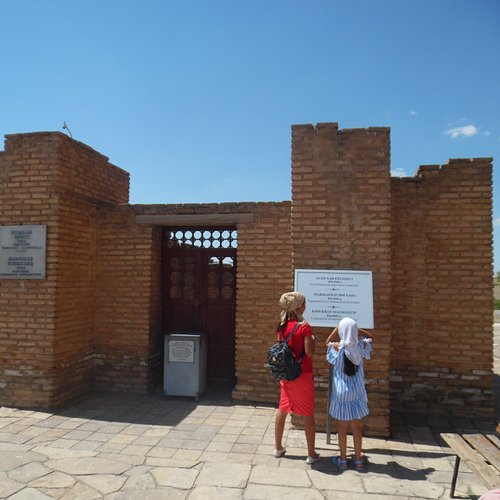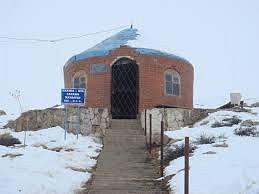What to do and see in Turkistan, Turkistan Region: The Best Sights & Landmarks
Discover the best top things to do in Turkistan, Kazakhstan including Esim Khan Mausoleum, Ukash Ata Maosoleum, Gaukhar Ana Mausoleum, Aulie-Kumchik Ata, Kultobe Hillfort, Railway Station Building, The Mausoleum of Khoja Ahmed Yasawi, The Intimate Ruins of Sauran, Juma Mosque, Mausoleum of Rabigi Sultan Begim.
Restaurants in Turkistan
1. Esim Khan Mausoleum
2. Ukash Ata Maosoleum
Overall Ratings
5.0 based on 3 reviews
The Mausoleum of Ukash-ata is the longest burial arranged for one person: a grave-sagan 22 meters long. They say that Ukash-ata was a fearless Arab warrior who in the 7th-8th centuries AD e. Islam and fire planted Islam among the Turkic tribes. On the territory of the mausoleum of Ukash-ata is located the well Gayyp-Bergen.
3. Gaukhar Ana Mausoleum
Overall Ratings
5.0 based on 1 reviews
The mausoleum of Gauhar ana, the daughter of Khoja Ahmed Yassawi is located in the southeast, 8 km from the mausoleum of H.A. Yassawi. She had the gift of a healer, who cured a lot of people. But she had no children
4. Aulie-Kumchik Ata
Overall Ratings
5.0 based on 1 reviews
The State Historical and Cultural Reserve-Museum "Azret Sultan" has 97 historical and cultural monuments, including the underground mosque Kumshik Ata. According to historical data, this underground mosque is closely connected with the name of Khoja Ahmed Yasawi. In all likelihood, there he wrote his religious - philosophical works, widely known in the east under the name "Hikmet" ("Wisdom").
5. Kultobe Hillfort
Overall Ratings
5.0 based on 3 reviews
The ancient city of Kultobe is the oldest part of Turkestan. It is located on the eastern edge of the modern city, which is the center of pilgrimage tourism and a historical monument of Kazakhstan. But only the archaeological excavations on the Kultobe hill can tell about the most ancient stages. The archaeological discovery of recent years was the architectural complex of the ancient citadel.
6. Railway Station Building
Overall Ratings
5.0 based on 2 reviews
Turkestan Station is part of a station buildings complex built during the construction of the southern branch of the Orenburg - Tashkent railway. It includes three main lounges: the lobby and waiting rooms for passengers of the first and second class. The architect specifically enhanced the importance of these rooms with high facades, which gives the building a solemn and elegant look.
7. The Mausoleum of Khoja Ahmed Yasawi
Overall Ratings
4.5 based on 105 reviews
Built in the 14th century by Tamerlane to commemorate the Sufi leader, the building is a national symbol.
Reviewed By 291genej - Silver Spring, United States
After visiting the Otrar Ruins and its nearby Arystan Bab Mausoleum, our guide drove 60 km north to this excellent site. We walked a long paved lane of Koranic Verses to a rose garden viewpoint of this beautiful Timurid Architecture. After paying 500 Kzt each, we entered the large hall featuring a huge 2 Ton bronze cauldron (returned from Russia's Hermitage), a front with historic candle holders, and original doors. No photography policy was being vigorously enforced but broken by many visitors. Very worthwhile site to include camel rides, drinking fresh camel's milk, and touring an underground mosque.
8. The Intimate Ruins of Sauran
Overall Ratings
4.5 based on 19 reviews
Reviewed By camsean - Townsville, Australia
Sauran Archaeological Site turned out to be a surprise hit of our trip to Kazakhstan. It is regarded as the best surviving medieval fort in the country and it is extremely photogenic. We were entranced by the mud-brick fortress walls, the blue skies and the palpable sense of history. If you want everything nicely restored and tidied up, this isn't the place for you. There has been mud-brick restoration on vulnerable parts of the walls, but the old walls are preserved under the recent additions. They haven't been demolished. There is one excavated section in the middle of the fortress which has numerous walls and cells. Again, new bricks serve as a lid to protect the original sections. Overall, this fortress is mostly a place to stir the imagination. You can imagine the White Horde ruling over the steppes from here and camels and traders coming down the Silk Road.
9. Juma Mosque
10. Mausoleum of Rabigi Sultan Begim
Overall Ratings
4.5 based on 4 reviews
The mausoleum is a beautiful monument of eastern architecture. Its central part is made in the form of a cylinder, the top is covered with domes. The mausoleum consists of five rooms. The monument has survived to our time in a very poor, destroyed state. The first research work was carried out in 1954 by the scientist K.A.Shaurin. In 1980, thanks to restoration work, the monument acquired its orig










